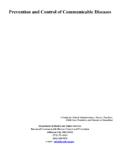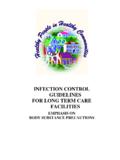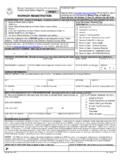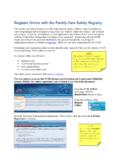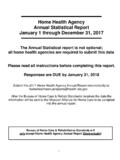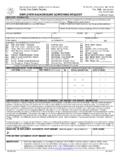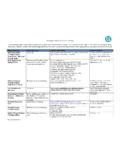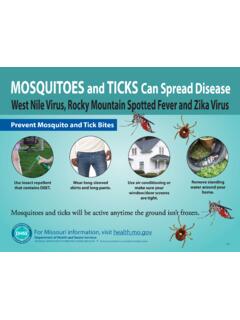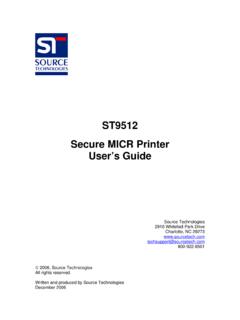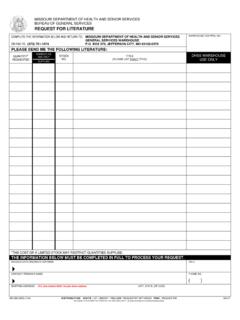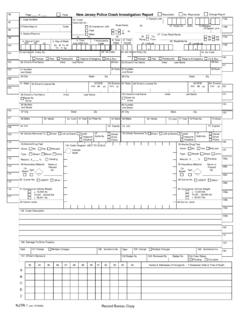Transcription of Diseases and Conditions Reportable In Missouri (19 …
1 Revised: 5/2016 Diseases and Conditions Reportable In Missouri (19 CSR ) Numbers in parenthesis represent ICD-10 Codes Report Diseases and Conditions to your local health agency or to: Missouri Department of Health and Senior Services during business hours 573-751-6113, after hours and on weekends 800-392-0272 or by fax 573-526-0235 1. Immediately Reportable Diseases or findings shall be reported to the local health authority or to the Department of Health and Senior Services immediately upon knowledge or suspicion by telephone, facsimile or other rapid communication. Immediately Reportable Diseases or findings are (A) Selected high priority Diseases , findings or agents that occur naturally, from accidental exposure, or as the result of a bioterrorism event (Y38, ).
2 Anthrax (A22, , ) Botulism ( , , ) Paralytic Poliomyelitis ( , , , , , ) Plague (A20) Rabies (Human) (A82, ) Ricin Toxin ( ) Severe Acute Respiratory Syndrome-associated Coronavirus (SARS-CoV) Disease ( , ) Smallpox (B03) Tularemia (suspected intentional release) (A21) Viral hemorrhagic fevers, suspected intentional ( , Ebola, Marburg, Lassa, Lujo, new world Arenaviruses (Guanarito, Machupo, Junin, and Sabia viruses), or Crimean-Congo virus) (A96, A98, A99) (B) Instances, clusters, or outbreaks of unusual Diseases or manifestations of illness and clusters or instances of unexplained deaths which appear to be a result of a terrorist act or the intentional or deliberate release of biological, chemical, radiological, or physical agents, including exposures through food, water, or air.
3 (Y38, ) (C) Instances, clusters, or outbreaks of unusual, novel, and/or emerging Diseases or findings not otherwise named in this rule, appearing to be naturally occurring, but posing a substantial risk to public health and/or social and economic stability due to their ease of dissemination or transmittal, associated mortality rates, or the need for special public health actions to control. ( , ) 2. Reportable within one (1) day Diseases or findings shall be reported to the local health authority or to the Department of Health and Senior Services within one (1) calendar day of first knowledge or suspicion by telephone, facsimile or other rapid communication. Reportable within one (1) day Diseases or findings are (A) Diseases , findings or agents that occur naturally, or from accidental exposure, or as a result of an undetected bioterrorism event.
4 Animal (mammal) bite, wound, humans Brucellosis (A23) Cholera (A00) Dengue virus infection (A90, A91) Diphtheria (A36, ) Glanders (Burkholderia mallei) ( ) Haemophilus influenzae, invasive disease ( , , , J14, ) Hantavirus pulmonary syndrome ( ) Hemolytic uremic syndrome (HUS), post-diarrheal ( ) Hepatitis A (B15) Influenza-associated mortality (J09, J10, J11) Influenza-associated public and/or private school closures (J09, J10, J11) Lead (blood) level greater than or equal to forty-five micrograms per deciliter ( 45 g/dl) in any person ( , , ) Measles (rubeola) (B05) Melioidosis (Burkholderia pseudomallei) ( ) Meningococcal disease, invasive (A39, ) Novel Influenza A virus infections, human (J09) Outbreaks (including nosocomial) or epidemics of any illness, disease or condition that may be of public health concern, including illness in a food handler that is potentially transmissible through food.
5 (A05) Pertussis (A37) Poliovirus infection, nonparalytic ( , , B91) Q fever (acute and chronic) (A78) Rabies (animal) Rubella, including congenital syndrome (B06, , ) Shiga toxin-producing Escherichia coli (STEC) ( , ) Shiga toxin positive, unknown organism Shigellosis (A03) Staphylococcal enterotoxin B ( ) Syphilis, including congenital syphilis (A50-A53, A65, , , ) T-2 mycotoxins ( , ) Tetanus (A33-A35) Tuberculosis disease (A15, A17-A19, B90, J65, , ) Tularemia (all cases other than suspected intentional release) (A21) Typhoid fever (Salmonella Typhi) (A01, ) Vancomycin-intermediate Staphylococcus aureus (VISA), and Vancomycin-resistant Staphylococcus aureus (VRSA) Venezuelan equine encephalitis virus neuroinvasive disease ( , ) Venezuelan equine encephalitis virus non-neuroinvasive disease ( , , ) Viral hemorrhagic fevers other than suspected intentional ( , Ebola, Marburg, Lassa, Lujo, new world Arenaviruses (Guanarito, Machupo, Junin, and Sabia viruses), or Crimean-Congo virus) (A96, A98, A99) Yellow fever (A95) (B) Diseases , findings or adverse reactions that occur as a result of inoculation to prevent smallpox, including but not limited to the following, ( ).
6 Accidental administration Contact transmission ( , vaccinia virus infection in a contact of a smallpox vaccinee) Eczema vaccinatum Erythema multiforme (roseola vaccinia, toxic urticaria) Fetal vaccinia (congential vaccinia) Generalized vaccinia Inadvertent autoinoculation (accidental implantation) Myocarditis, pericarditis, or myopericarditis Ocular vaccinia (can include keratitis, conjunctivitis, or blepharitis) Post-vaccinial encephalitis or encephalomyelitis Progressive vaccinia (vaccinia necrosum, vaccinia gangrenosa, disseminated vaccinia) Pyogenic infection of the vaccination site Stevens-Johnson Syndrome ( , ) 3. Reportable within three (3) days Diseases or findings shall be reported to the local health authority or the Department of Health and Senior Services within three (3) calendar days of first knowledge or suspicion.
7 These Diseases or findings are Acquired immunodeficiency syndrome (AIDS) / Human immunodeficiency virus (HIV) infection (B20) Babesiosis ( ) California serogroup virus neuroinvasive disease ( ) California serogroup virus non-neuroinvasive disease ( ) Campylobacteriosis ( ) (Continued on page 2) Revised: 5/2016 Carbon monoxide exposure (T58) CD4 + T cell count and percent Chancroid (A56) Chemical poisoning, acute, as defined in the most current ATSDR CERCLA Priority List of Hazardous Substances; if terrorism is suspected, refer to subsection (1)(B) Chlamydia trachomatis infections (A55, A56, A74, ) Coccidioidomycosis (B38) Creutzfeldt-Jakob disease ( , ) Cryptosporidiosis ( ) Cyclosporiasis ( ) Eastern equine encephalitis virus neuroinvasive disease ( ) Eastern equine encephalitis virus non-neuroinvasive disease ( ) Ehrlichiosis / Anaplasmosis, human (E hrlichia chaffeenis, Ehrlichia ewingii, and Anaplasma phagocytophilum infection) and undetermined ( ) Giardiasis ( ) Gonorrhea (A54, ) Hansen s disease (Leprosy) (A30) Heavy metal poisoning including, but not limited to, arsenic, cadmium and mercury ( , , , , , )
8 Hepatitis B, acute (B16, ) Hepatitis B, chronic ( , , ) Hepatitis B surface antigen (prenatal HBsAg) in pregnant women (B16, , , ) Hepatitis B Virus Infection, perinatal (HbsAg positivity in any infant aged equal to or less than twenty-four (< 24) months who was born to an HbsAg-positive mother) (B16, , ) Hepatitis C, acute ( , ) Hepatitis C, chronic ( , ) Human immunodeficiency virus (HIV) infection, exposed newborn infant ( , newborn infant whose mother is infected with HIV) ( ) Human immunodeficiency virus (HIV) infection, including any test or series of tests used for the diagnosis or periodic monitoring of HIV infection. For series of tests which indicate HIV infection, all test results in the series (both positive and negative) must be reported (B20) Human immunodeficiency virus (HIV) infection, including any negative, undetectable, or indeterminate test or series of tests used for the diagnosis or periodic monitoring of HIV infection conducted within 180 days prior to the test result used for diagnosis of HIV infection (B20, R75, ) Human immunodeficiency virus (HIV) infection, pregnancy in newly identified or pre-existing HIV positive women (B20) Human immunodeficiency virus (HIV) infection, test results (including both positive and negative results)
9 For children less than two years of age whose mothers are infected with HIV (R75, , ) Human immunodeficiency virus (HIV) infection, viral load measurement (including nondetectable results) (B20) Hyperthermia ( , X30) Hypothermia (T68, X31) Lead (blood) level less than forty-five micrograms per deciliter (< 45 g/dl) in any person ( , , ) Legionellosis ( , ) Leptospirosis (A27) Listeriosis (A32, ) Lyme disease ( ) Malaria (B50-B54, , ) Methemoglobinemia, environmentally-induced ( , ) Mumps (B26) Non-tuberculosis mycobacteria (NTM) (A31) Occupational lung Diseases including silicosis, asbestosis, byssinosis, farmer s lung and toxic organic dust syndrome ( , J61, , J66, , , ) Pesticide poisoning ( , ) Powassan virus neuroinvasive disease ( ) Powassan virus non-neuroinvasive disease ( ) Psittacosis (A70) Rabies Post-Exposure Prophylaxis (Initiated) ( ) Respiratory Diseases triggered by environmental contaminants including environmentally or occupationally induced asthma and bronchitis ( ) Rickettsiosis, Spotted fever ( , , ) Saint Louis encephalitis virus neuroinvasive disease ( ) Saint Louis encephalitis virus non-neuroinvasive disease ( ) Salmonellosis (A02)
10 Streptococcus pneumoniae, Invasive disease (IPD-Invasive Pneumococcal Disease) ( , , J13) Streptococcal toxic shock syndrome (STSS) Toxic shock syndrome, non-streptococcal (TSS) ( ) Trichinellosis (B75) Tuberculosis infection ( ) Varicella (chickenpox) (B01) Varicella deaths (B01) Vibriosis (non-cholera Vibrio species infections) ( , , ) West Nile virus neuroinvasive disease ( , ) West Nile virus non-neuroinvasive disease ( , , , ) Western equine encephalitis virus neuroinvasive disease ( , , ) Western equine encephalitis virus non-neuroinvasive disease ( , ) Yersiniosis ( , ) 4. Reportable weekly Diseases or findings shall be reported directly to the Department of Health and Senior Services weekly.
